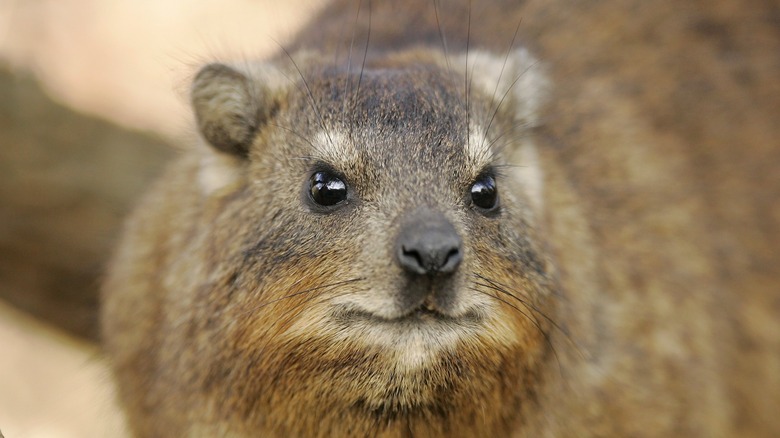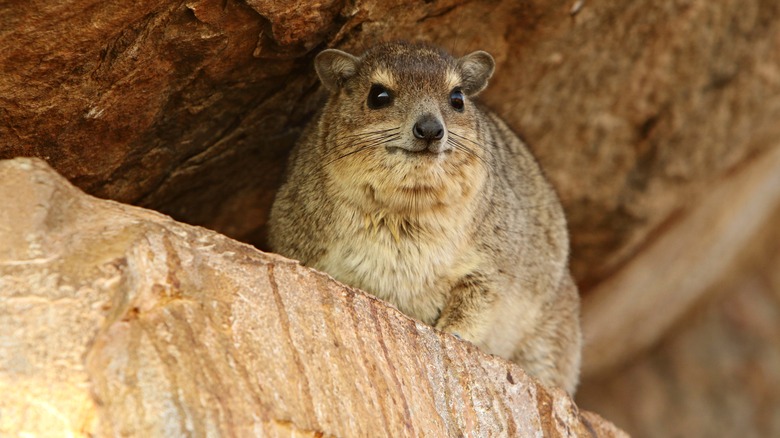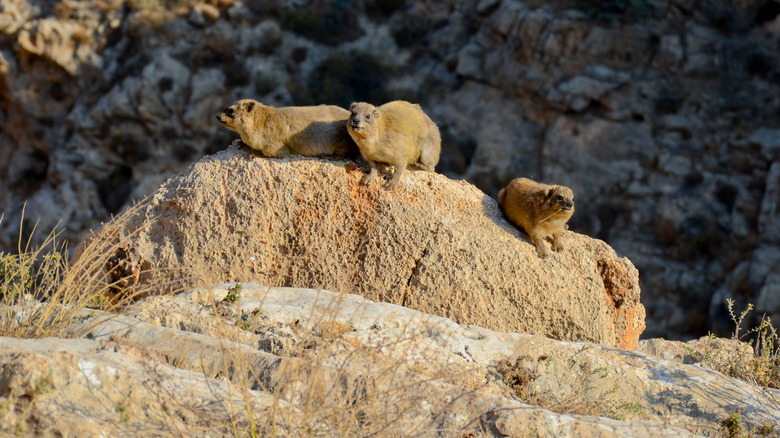The Closest Living Relative To The Elephant Is Smaller Than You Would Think
Elephants have scored themselves leading roles in history's most common popular nursery rhymes, in iconography for political parties, and as anthropomorphized main characters in franchises ranging from Dumbo to Babar. But their less-acclaimed dearest relative — the rock hyrax (Procavia capensis) — is rarely even mentioned in popular science books.
Many have searched for a resemblance between the elephant and the rock hyrax, but the two don't share much familial resemblance in appearance at all. These highly-social herbivores may look unremarkable at first sight, but they're well-connected: the rock hyrax's closest earthly relatives include elephants and manatees. According to the Los Angeles Zoo and Live Science, the hyrax and elephant broke off from their common ancestor almost 60 million years ago. That ancestor, however, is the proud progenitor of three familial lines: the rock hyrax, the manatee, and the elephant. All three descend from the line originating with this member of tethytheria, which today has diverged into the species we recognize well — and the ones we don't.
What Is A Rock Hyrax?
The rock hyrax (also known as the rock rabbit or rock dassie, according to Smithsonian's National Zoo & Conservation Biology Institute) is a round, furry, four-legged mammal with excellent sight and hearing. These creatures reside in kopjes, which are cliffs, or other rocky crevices of Lebanon, Jordan, Israel, and a range of African habitats (via the Los Angeles Zoo). According to Smithsonian, the large amounts of calcium carbonate in their urine tends to turn their cliff-dwellings white. Their urine has also been used historically by both African tribes and Europeans as an ingredient in traditional medicines for epilepsy.
Hyraxes' feet are rubber-like, with moist soles and a muscular indentation that allows them to form suction attachments to cliffs or rocks for climbing. Their long claws are used for grooming and scratching. According to Smithsonian, their unique feet musculature makes the hyrax a skillful climber and agile jumper.
Rock hyraxes are 1-2 feet long and 4-12 pounds heavy
The rock hyrax is a furry-faced, four-legged mammal that looks more like a guinea pig than it does its nearest relative: the almighty elephant. It burrows its life away in the rocky crevices of Africa and the Middle East, where they live in colonies of 5 to 60 members (per Smithsonian's National Zoo & Conservation Biology Institute). These gregarious beings are approximately 1-2 feet long, between 4-12 pounds heavy, and don't bear much resemblance to the elephant at first glance. Weighing in at somewhere between 4-12 pounds, the rock hyrax is roughly the size of a hedgehog or guinea pig. However, according to the Los Angeles Zoo, they do retain tiny elephantine tusks.
Hyraxes are sociable, gregarious creatures who live in familial pods comprised of one male and multiple females, or otherwise of all bachelors. Hyraxes hide away in the rain (via Smithsonian National Zoo & Conservation Biology Institute) and spend less than an hour each day eating. These tiny beings' conservation status is classified as "Least Concern" (via the Los Angeles Zoo), unlike elephants, which have been marked "Endangered" by the WWF.


